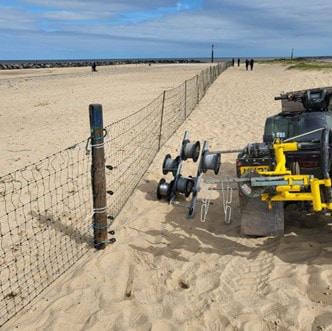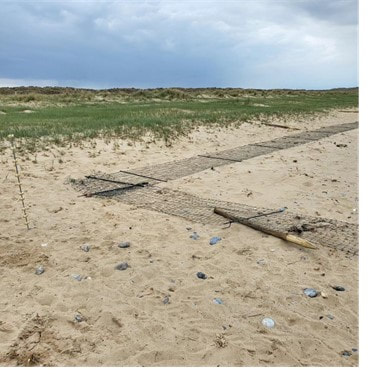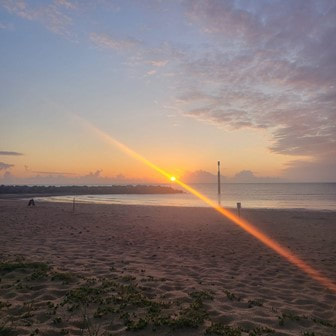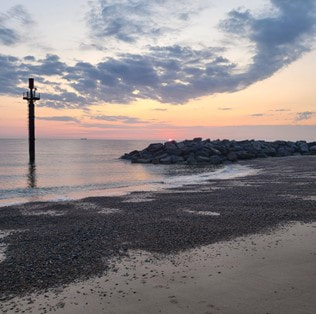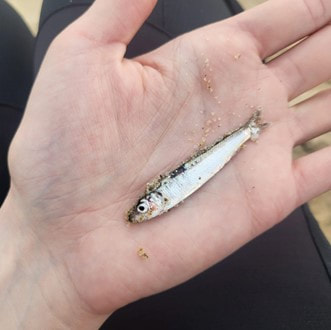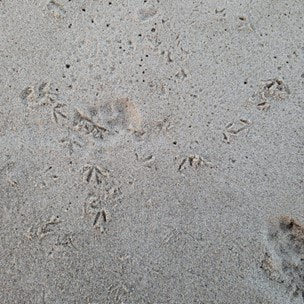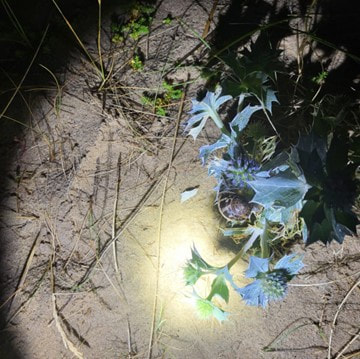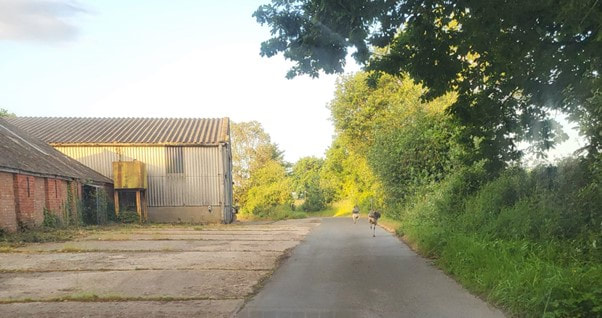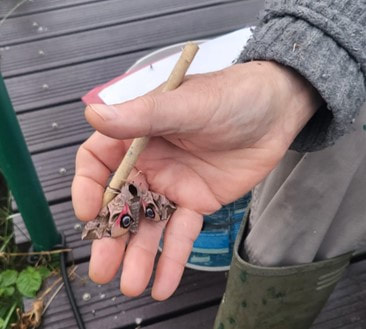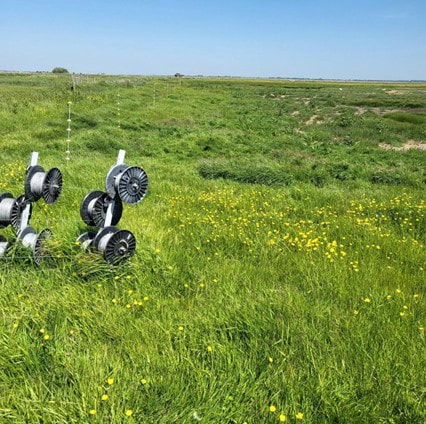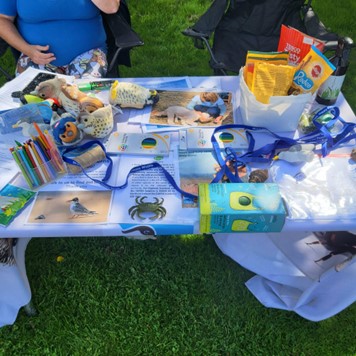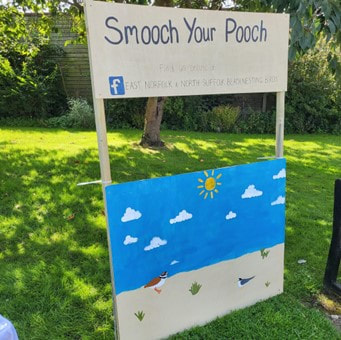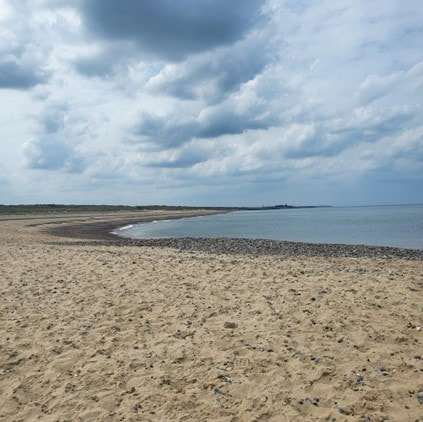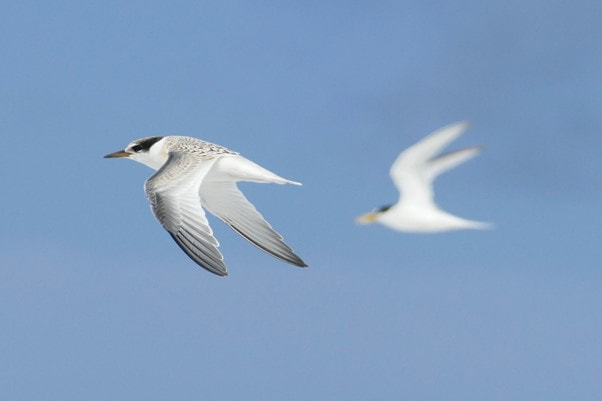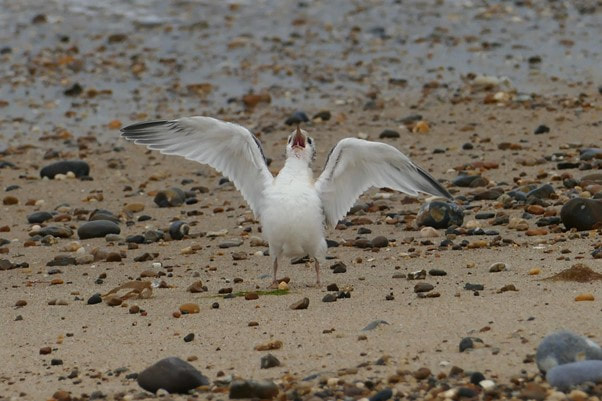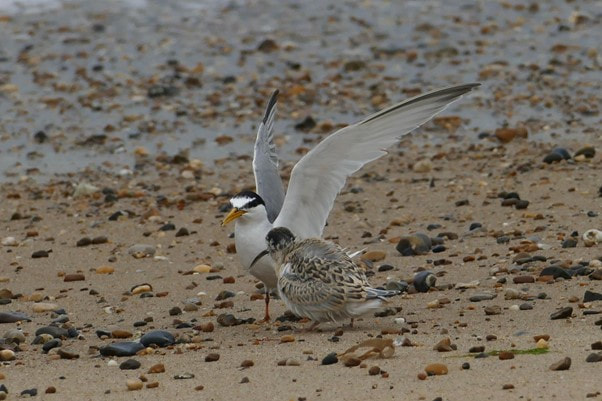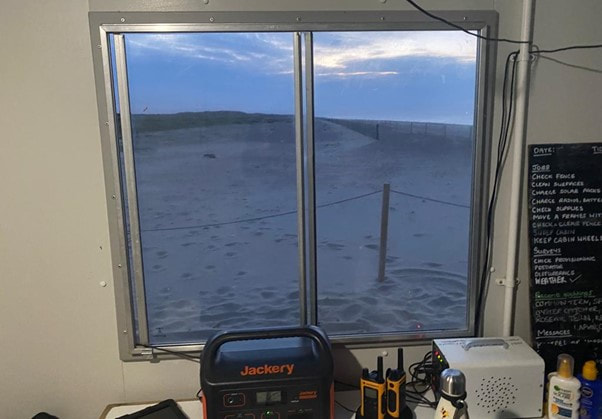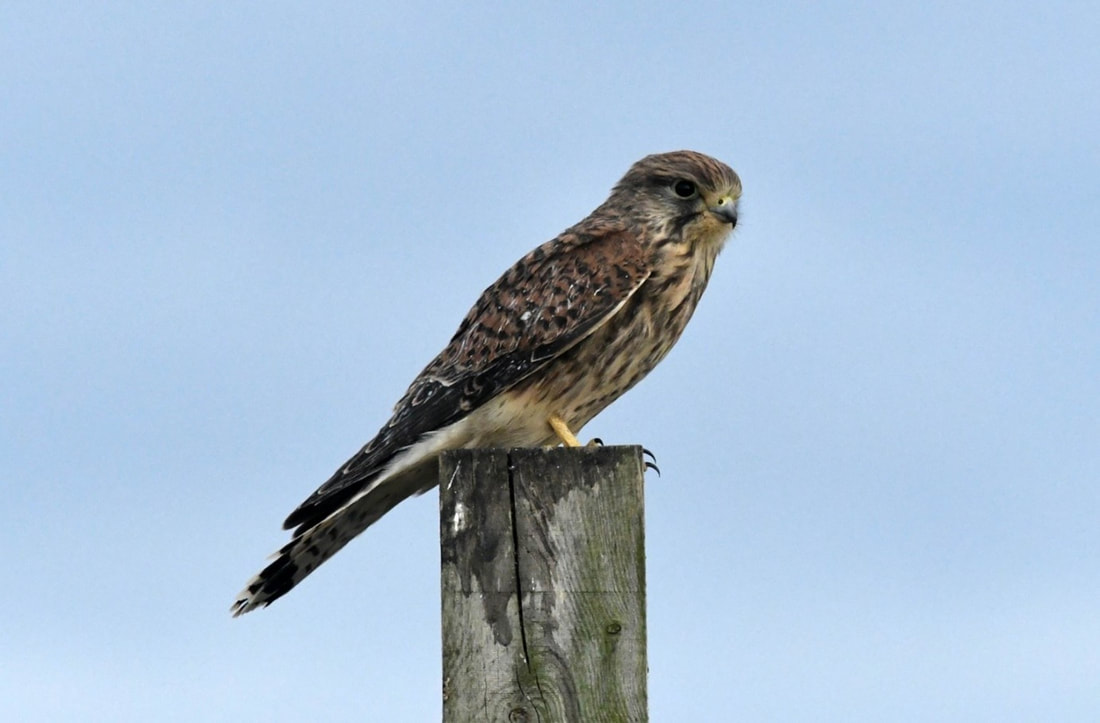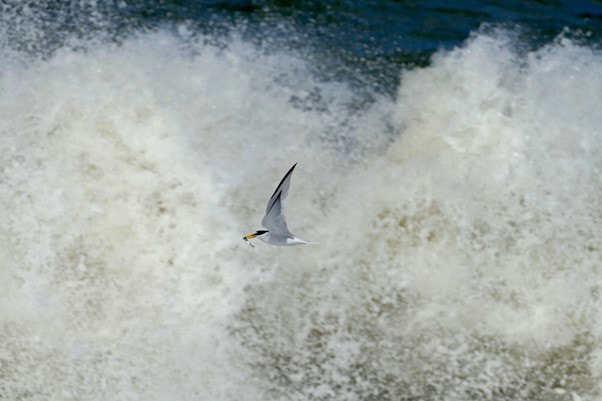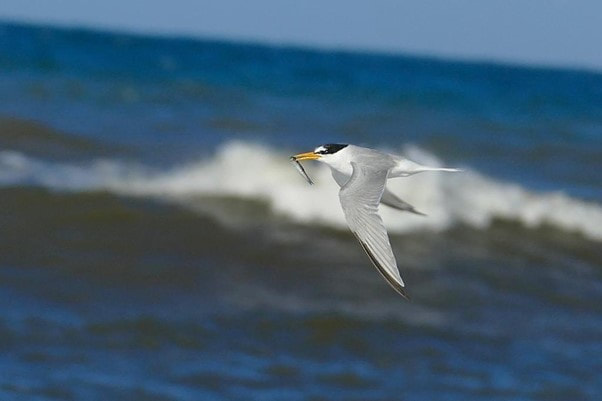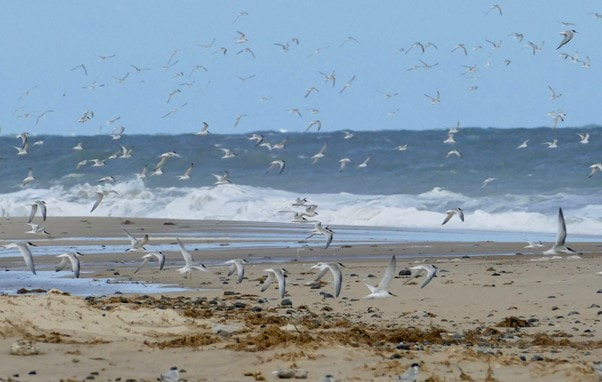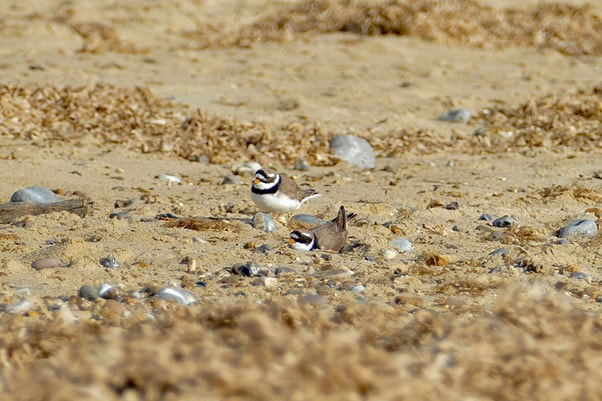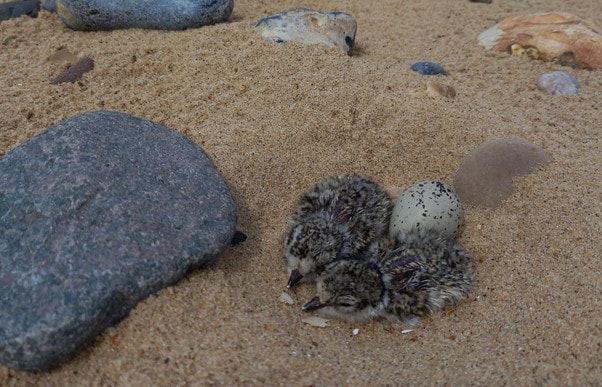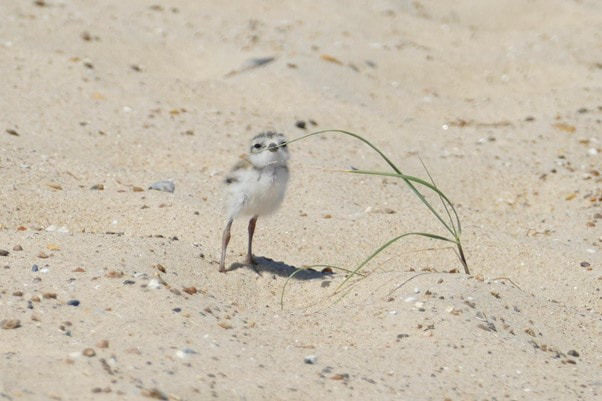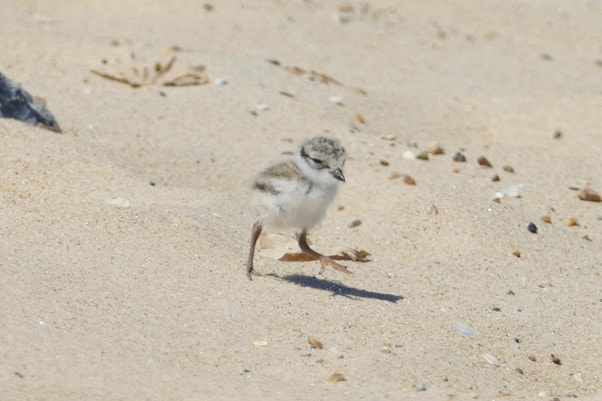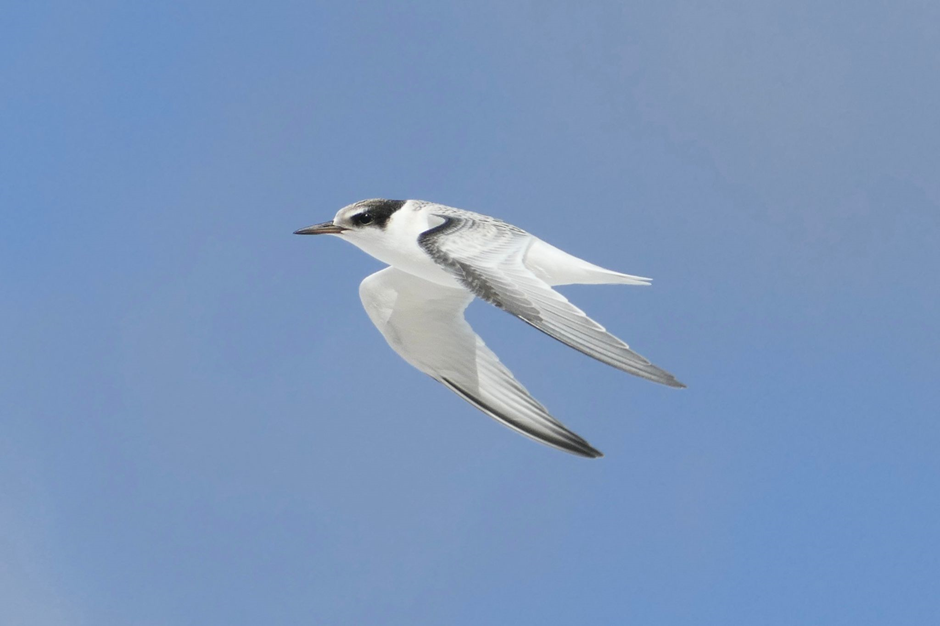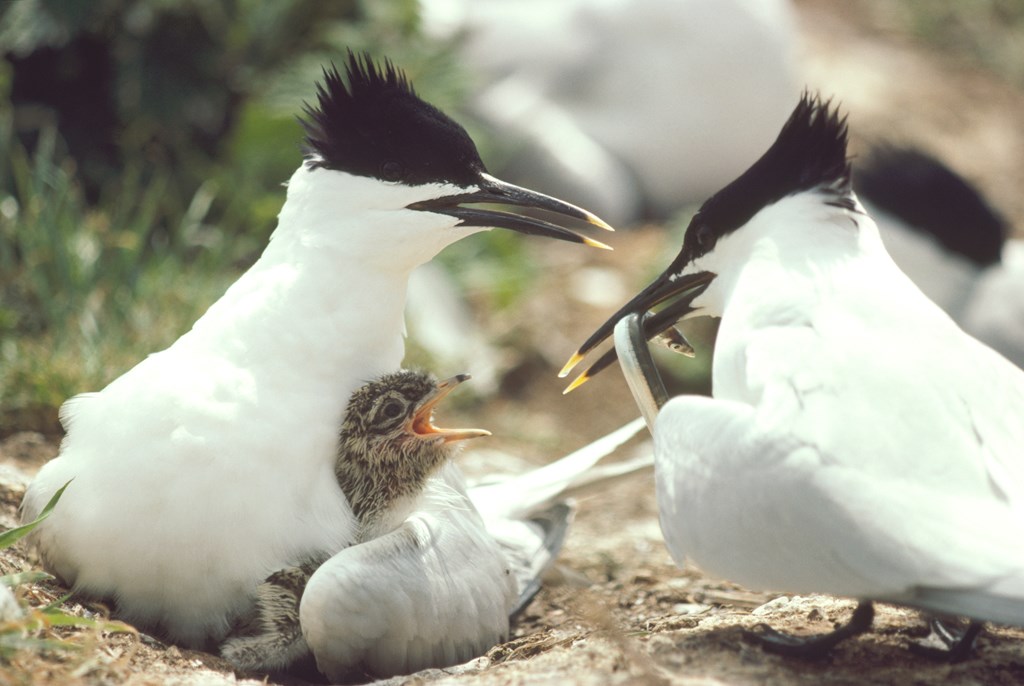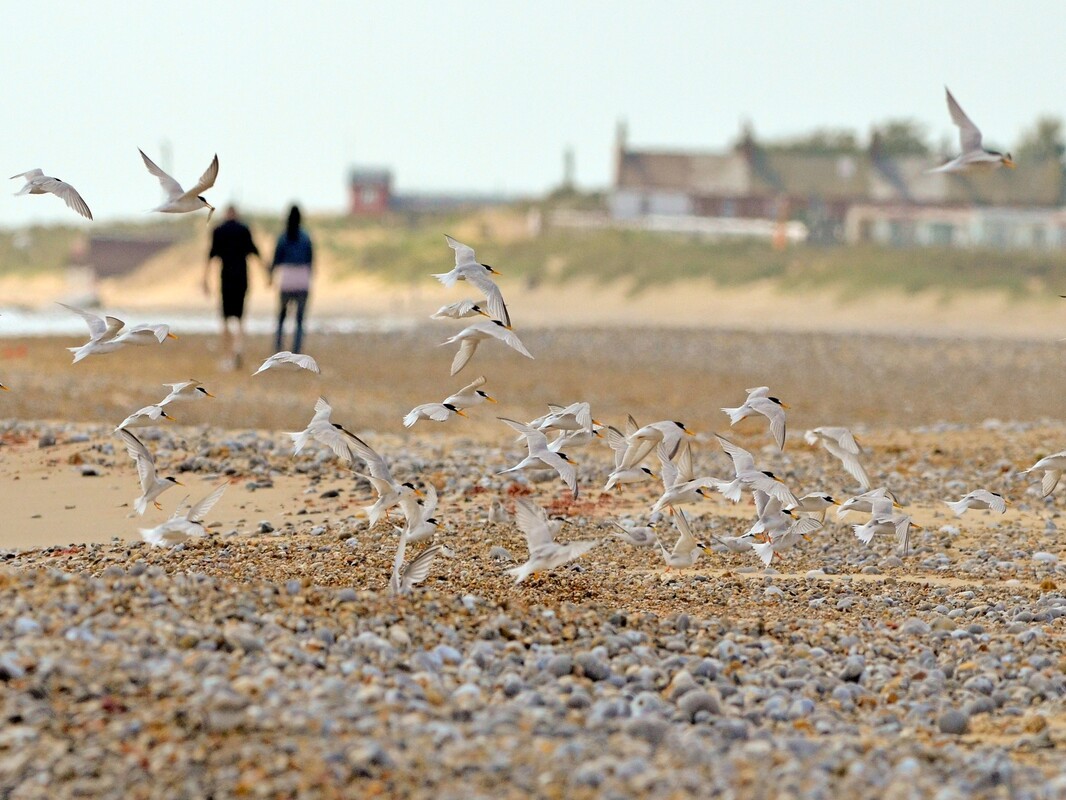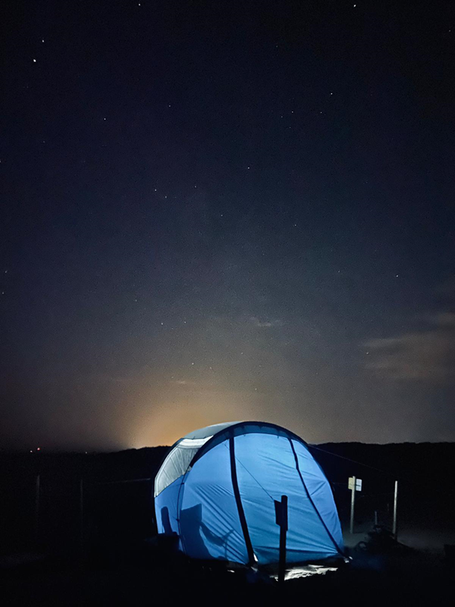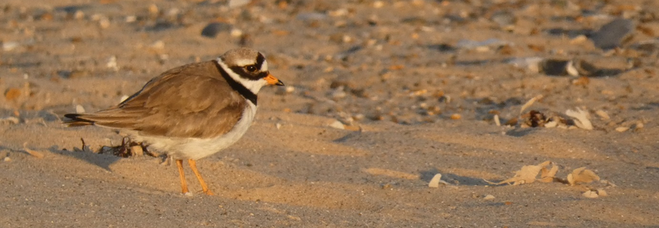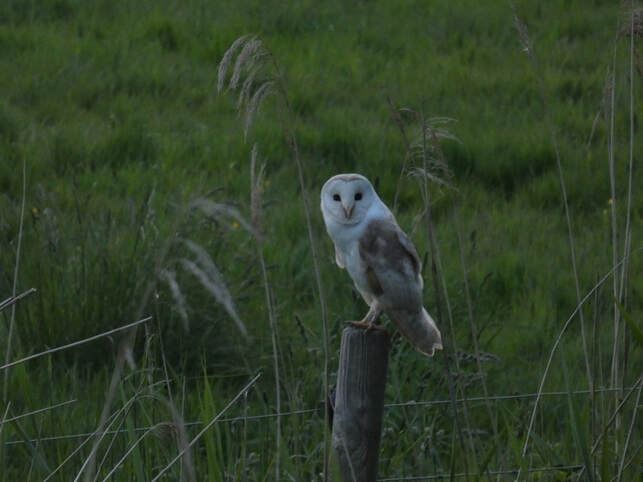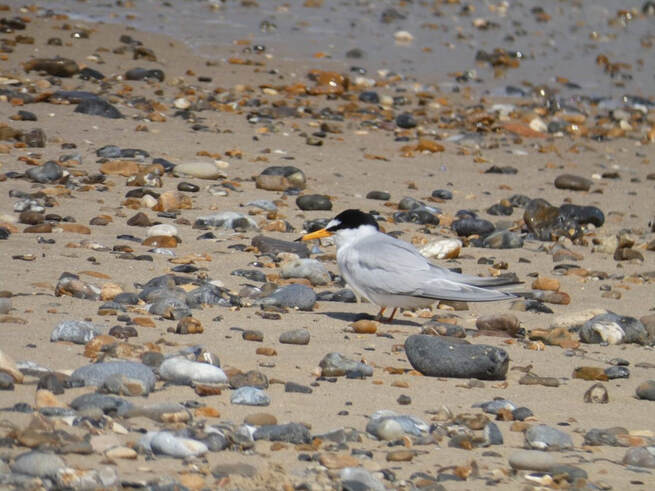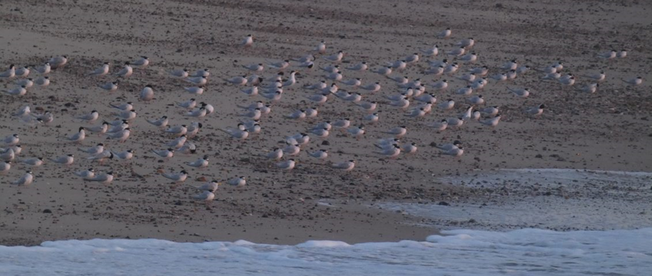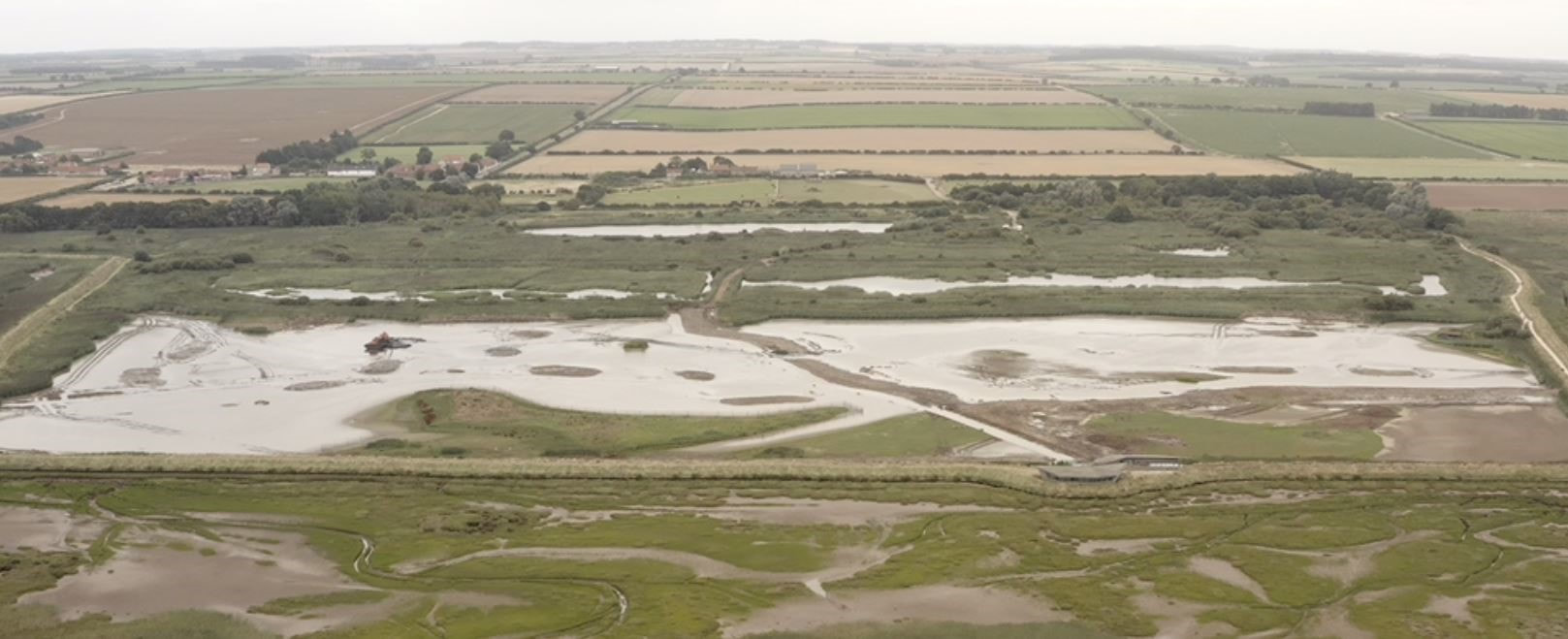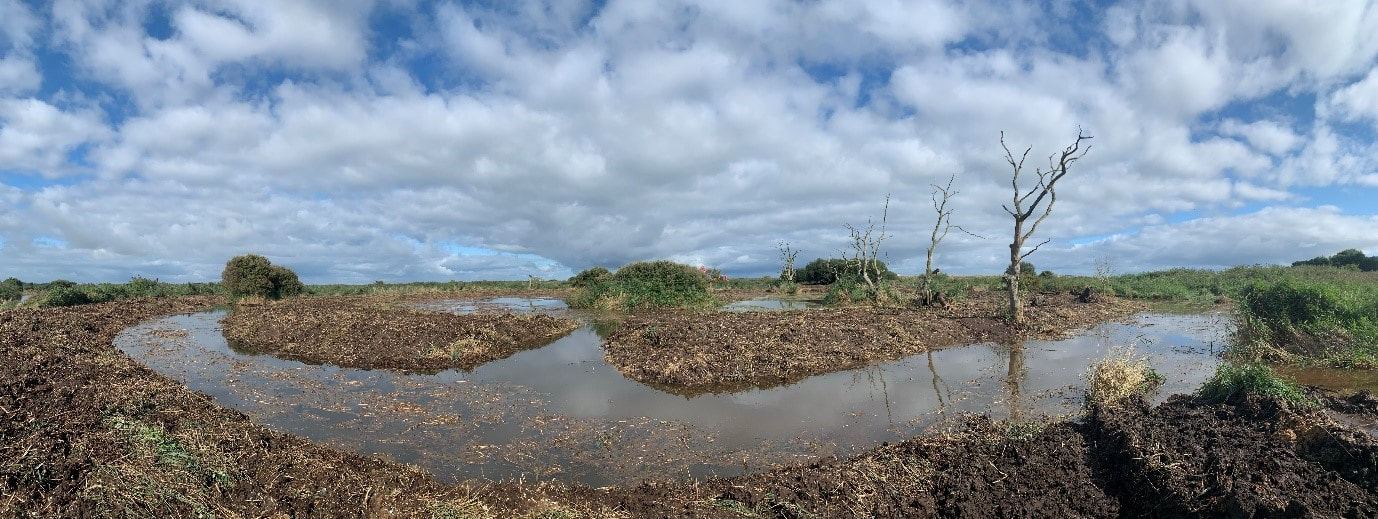|
Thanks to Rebekah Wall, RSPB Little Tern Volunteer, for this lovely guest blog. Conservation is something you’ll commonly find on the news but is such an important topic for the generation these days. To take part in it is something even more important and wonderful. Conservation is my career path and to have the option to become a volunteer is very rewarding and has been something I have done since graduating from University. I applied to be a bird warden for the RSPB in April (2023) for something new to volunteer for, to improve my mental health, and to be more involved in the current need to support conservation and breeding opportunities for the Little Terns. To be given the opportunity to work amongst RSPB staff and experienced volunteers and to be working closely with the Little Terns, a thrill of excitement made me ecstatic, and I was looking forward to starting my shifts. As well as actually working alongside the Little Terns, the fences needed to be put up at Winterton-on-sea and at Eccles. Many volunteers popped up to help and it was interesting to talk with the new and experienced volunteers about what to expect from a shift and how to engage with the public and their dogs. During the induction, one of the staff spoke about the night shifts, the golden hour that we could witness, and the experiences we could obtain. Instantly I knew I wanted to do as many night shifts as I could, fitting it around my day job. I began my first night shift at 10 p.m. in the middle of June, wrapped up warm with many layers, thermals, waterproofs, a woolly hat, gloves, flask filled with hot coffee and snacks. Sitting in a camping chair can be very comfy until it gets very cold. Fortunately, blankets were available to use and sudden spurts of bats and moths flew over one's head and gave me a buzz, excitedly looking for more wildlife in the sky. The night shifts were so different from the day shift. As said by previous volunteers, you get to witness the golden hour which was so magical to see. You have to watch the birds wake up from their hiatus as they are always on the watch, protecting their eggs, chicks, and colony. To witness them fly up, fluttering over the sea and quickly in dive to catch any amongst the Clupeidae sp. to give their chicks the first meal of the day. Listening to their calls is so distinct, made my heart flutter. And the first time I saw a chick, my heart burst into happiness, knowing for a fact this is the environment I want to be in. How small they are! Little balls of speckled fluff. During the night shifts, you literally have to be the watchful eye, a protector to help the success of the breeding Little Terns. To physically chase away the predators with a shaker (a bottle with small stones and pebbles in it). Whether they are flying raptors and four-legged mammals - muntjacs for the eggs, foxes for the eggs and chicks, a few domestic cats now and again, and the occasional squirrel. Finishing a night shift every morning is very different from the last. One morning, driving on my way home from a night shift I happened to come across a situation quite bizarre. Two Rheas were running on a country road right in front of me in the car. Completely bewildered I thought I may have been over-tired. I managed to snap some shots and pass them on to the Little Tern group. A few hours later, I was informed that they were from a farm and had escaped, I saw two of the twelve that were roaming around Norfolk. As well as strange occurrences, I was able to witness a couple of moth traps being unveiled! The beauty of the elephant hawk moths to the peppered moths was amazing and enticing to watch. Working as a bird warden is so much more than looking after the birds, you are able to gain transferable skills, work as a team, get the chance to take part in other events such as witnessing kestrel chicks being ringed, working on RSPB sites such as Berney Marshes engulfed in magical greenery and wildlife, many bird species and mammals and public days such as ‘’Smooch your Pooch’’ promoting dogs on leads during the breeding season of the Little Terns. Being given the chance to take part in volunteering alongside the RSPB for the past five months has been an amazing opportunity that I have thoroughly enjoyed and look forward to the next season.
3 Comments
By Will Bevan – Beach-Nesting Bird Field Officer in East Norfolk After spending last summer helping to protect the beach-nesting birds of East Norfolk, in April this year I was eagerly anticipating my return for another season. Being largely nocturnal in 2021, with my exploits as a night warden detailed on this blog, in 2022 I returned as a fully-fledged Field Officer. Our work covers three sites in East Norfolk and North Suffolk, with a team of dedicated volunteers and Field Officers working day and night over the breeding season to provide protection. Methods involve three sets of fencing (rope, electric, and poultry netting), signage, round the clock wardening, and public engagement and education on the beach and in the wider community. The focus is mainly on little terns, but this protection benefits other beach-nesting birds including ringed plovers, oystercatchers, and avocets. Little tern conservation is fraught with worry, as the odds seem to be stacked against them so heavily it is a wonder that any chicks fledge! Nesting in vulnerable spots on shingle beaches just above the tideline, they face numerous threats including human disturbance, dogs off leads, egg thieves, high tides and stormy weather (made worse by climate change), and predation from ground and aerial predators. Despite early disappointment last year with failures at two of our colony sites, mainly due to aerial predation pressure, the season ended up being a success overall with these failed birds moving to another site and re-laying, with around 137-216 fledglings leaving in mid-August. However, this was still just below the productivity target of 0.75 required to maintain or increase the population. This result also highlighted the importance of having several sites set up and ready to receive little terns which might fail elsewhere but have a second attempt at breeding in another location. With all this and stories from previous seasons in mind, it’s always a good idea not to raise hopes too high early in the season, as any number of things can go wrong. However, it was hard to not to be excited this year as the breeding got under way at the start of May. Whilst last year the terns took longer to prospect potential nest sites, eventually spreading out over all three of our protected colony areas, this year they settled in just one location. From our first egg being found on the 21st of May, just two weeks later we were counting around 300 active nests, making it the largest colony in the UK in 2022. This is compared to a peak count of 116 nests at the same site last year! The excitement started to spread as we realised that we might have a mega year on our hands. When managing several colonies there is always a difficult choice to be made because resources are limited, especially when it comes to the time of the volunteers and Field Officers. In many years the colony with the largest number of nests is prioritised as the one which receives the most protection, although a presence is still maintained at all sites. This is difficult because every breeding pair counts when it comes to little terns, with a potential for two or three fledglings which may live for two decades and have many more offspring over that lifespan. It was a relief this year to be able to put everything into one site, allowing us to have a more of a presence to deter predators and egg thieves, as well as to engage with the public on the beach. A cabin was brought down to the site for all our amenities, with solar powered lights for night shifts and a generator for charging equipment. This was a great place to get out of the weather, especially with the extreme heat we have had so far this year, as well as for observing the colony. From my experiences last year out at night in a tent, which flapped uneasily in the wind, the cabin made the night shifts almost luxurious in comparison. The first hatching date approached in mid-June with eager anticipation, as well as an increase in nerves. In previous years kestrels have been a large cause of mortality for younger chicks and fledglings, and on occasion decimated the colony. For example, a report from 2001 when the little terns nested at Great Yarmouth states that kestrels took a total of 526 chicks! Whilst we have been doing work on diversionary feeding to try and provide local kestrels with alternative food sources, a determined adult will continue to go after the terns despite our best efforts. The first tern chicks were sighted on the 14th of June and the weeks went by with only glimpses of kestrels, which luckily didn’t show interest in the colony. This did not stop the terns giving them hassle! A hobby started visiting regularly, trying to take adults and chicks, but the sheer number of little terns watching for predators and willing to mob them was enough to deter it on most occasions. This confidence lessened as the terns began to leave, and unfortunately for a few stragglers remaining towards the end of July, the hobby was much more successful. High spring tides can also be a challenge for the little terns, especially combined with strong north and easterly winds coming off the North Sea. Nests can be moved a small amount at a time, so long as we make sure to replicate the pattern of stones around the nest, but if the tide is high enough it can wipe out a large percentage of the colony. Luckily, we had no incidents where the nests were at risk this season, with the highest tides not coinciding with strong winds. Public engagement on the beach was also very positive this year, and this is a key part of our work in making people more aware of beach-nesting birds on the coast and educating them about responsible dog walking. I had some great conversations with those who knew about the birds already and many who were seeing them for the first time, and it was rewarding to be able to use scopes to allow adults and children to see the chicks up close. Dog owners were more than happy to put their pets on leads, showing that effective signage and friendly engagement can lead to positive behavioural changes. Little terns also need plentiful stocks of small fish in shallow water near to the colony, and this seemed to be no problem for them this year as they were constantly flying to and from the sea with fish for their growing young. It seemed like the stars aligned for this year’s season, and the full scale of what the terns had accomplished became apparent as the fledgling numbers built up on the shore. Our fledgling count was a whopping 585 on the 14th of July, and this is the lower estimate, with a potential for between 650- 700 leaving the site overall. This year was also productive for our ringed plovers, with a total of 17 nests and 18-25 fledged across our sites. Usually, plover nests are spread out along the coastline, but many choose to nest within our fencing as they are much less likely to be disturbed. For rogue pairs outside our main fence, we can put up some posts with a bit of rope and cross our fingers, and this year we had eggs successfully hatching from just such a nest! We also had two oystercatchers and three avocets fledge from our Suffolk site. Another joy of the season was watching a pair of plover chicks grow up into fledglings which had become habituated to our presence around the cabin, and on a night shift they often would run around my feet as I sat out in a camping chair! In a year when there has been lots of bad news, especially with bird flu and how it has affected our struggling bird populations, it is a relief to be able to share something positive. Although every year is different, we are all hoping that this is the beginning of a trend where we can start stabilising or even increasing the numbers on the East Coast and the U.K. Once again this has only been possible thanks to a truly incredible team of volunteers and staff, an extremely supportive local community, and the funding and support of Natural England and Great Yarmouth Borough Council. Blog by Leigh Lock, RSPB Project Development Manager The global and national threats to seabirds are widely recognised and much focus understandably links the status of seabirds with the state of our seas which is where most seabirds spend most of their time. But what about the state of the ‘land’ where seabirds spend the breeding season – a critical phase of their lifecycle? As a land-based observer of birds on the coast for decades, the growing pressure on breeding seabird sites has been a major concern and I feel we have reached a tipping point where if we don’t act now there will be no safe nesting space left for seabirds in some areas in the future. Therefore, I was excited by the prospect of Seabird Conservation Strategies being developed within all four UK counties by government – each will set out the strategic needs of our seabird species and set out a route map for their recovery. This process in England has been led by DEFRA and NE. But I wanted to make sure that the current state of seabird colonies in England was reflected in this process and that the thoughts and concerns of those most close to the sites – the site managers, conservation officers etc responsible for these areas– were captured. So I contacted as many of those key people around the coast as possible to gather views on pressures impacting on seabird colonies. This is probably the first time such an assessment has been made. Much of this information gathered was necessarily subjective, being based on the opinions of the site managers, and others. However, expert judgement provided by the site managers most familiar with the sites, and their issues, constitutes the best available evidence on issues affecting England’s breeding seabirds. The process does present a ‘ground truthing’ to compare with other available data sources so that all the available information together can be used as ‘weight of evidence’ to identify the main issues and develop solutions to them. Working closely with colleagues within NE, we then looked to align this rather broad-brush assessment of pressures on colonies with other data sources being carried out to inform other areas of the strategy. Information was gathered on 222 natural sites (i.e., excluding urban gulls) and covering 24 seabird species – this representing the vast majority of England’s seabirds. Pressures were assigned to predefined categories including disturbance, habitat loss, predation, invasive species, disease, and control. Note that the assessments were carried out before the widespread and serious impacts of Avian Influenza (AI) were recorded in England in 2022. Overall, the most widespread was disturbance (see below), with both habitat loss and predation impacting on over 50% of the sites. The other pressures were recorded at far less sites, although their impacts at individual sites could be very significant (e.g., invasive species on islands). There are plenty of discussion points emerging from this but below I have pulled out just three. 1. The widespread impacts of disturbance Disturbance is the most widely reported pressure affecting England’s breeding seabirds impacting on 89% of the coastal sites, all sites supporting species like little tern and Sandwich tern, and 100% of English SPAs with breeding seabird features. Site managers see disturbance as THE rapidly growing issue, and human recreational disturbance at coastal sites is predicted to increase. Disturbance of nesting seabirds is caused by a range of recreational activities – beachgoers, dogwalkers and recreational fishers on land, and recreational watercraft such as jet skis, paddleboarders from the sea. Although disturbance is particularly an issue for ground-nesting birds such as terns and gulls at soft coast sites, I was also surprised how widely it was reported at cliff colonies and even offshore islands where birds vulnerable to disturbance from the sea. Disturbance at nest sites can have significant negative impacts on seabird breeding success through increased exposure of eggs and young to predation and the elements and can lead to the abandonment of nest sites and even entire colonies. What I see are overstretched, under resourced conservation organisations trying to manage coastal sites where nature conservation should be the priority, but recreational interests prevail. Many areas have wardens to ‘protect’ nesting birds and engage with the public. But without zonation policies and legislation to restrict certain activities, on-site teams of staff and volunteers face an uphill battle, and the birds using these sites face a bleak future. 2. Sea level rise and coastal erosion present an existential threat to some of England’s most important seabird colonies. Within England, most seabird sites occur on ‘soft coast’ sites – nearshore islands, salt marshes, lagoon islands and shingle banks. These habitats are under massive pressure and the reduction in size and quality of nesting habitat is the second most widespread pressure in England. Without intervention, 2,000 Ha of protected coastal habitats is predicted to be lost in England by 2060 with even greater areas being functionally lost as breeding habitat due to regular flooding. Previously, these losses were mainly from development and land claim, but the key future threats to coastal habitats are from climate change-related sea level rise, coastal erosion, and coastal squeeze. Mean sea levels in the UK have already risen by approximately 17 cm since the start of the 20th century and climate predictions show that they will continue to rise under all emissions scenarios until at least the year 2100. Increases in sea level rise are difficult to predict but are likely to be greatest in southern and eastern England where some of the largest colonies are. Rising sea levels mean that more coastal seabird breeding habitat will be lost, and the risk of intermittent flooding of nest sites is also increased. In addition to mean sea level rise, the risks of extreme sea levels and flooding are compounded by increases in storm events. Species that nest on the ground in sand and shingle habitats, such as terns and gulls, are particularly at risk, as large areas of these types of habitats can be lost rapidly with only minor increases in sea level. Many current breeding sites for terns and gulls on beaches and low-lying near-shore islands which are likely to become unsuitable or be lost entirely within the next 10 years. Little terns are particularly at risk because they tend to nest just above the high-water mark and in recent years high proportions of the UK’s little tern nests have been flooded out during spring tides and storm surges. Short term fixes are in place at many sites. Habitat management to keep sites open, recharge of shingle islands to raise their levels above highest tides but longer-term measures are required to ensure that seabirds have safe nesting sites for future decades not just the next few years. This involves factoring seabird breeding habitat into multi-stakeholder strategic management planning eg Shoreline Management Plans (SMPs), Nature Recovery Networks (NRNs), Local Nature Recovery Strategies (LNRS)) and the implementation of the government’s 25-year Environment Plan. Breeding seabirds should be considered in full as part of these overarching plans and programmes, to ensure that existing breeding sites are adequately managed, and new breeding habitat is created and maintained, and linked to funding streams like Biodiversity Net Gain.  Beneficial use of dredged sediment can be used more widely to provide habitat for nesting seabirds and provide natural sea defences – here 50,000 cubic metres of sediment delivered through @ProjectLOTE working with Harwich Haven Authority, EA and the landowner supports the most important little tern colony in Essex (c) JPullen 3. Avian Influenza and the in-combination effects.
As mentioned above, the assessment was carried out last year before the impacts of AI were recorded in England this summer. Disease was not noted as a significant pressure and has not really impacted on seabirds since botulism on gulls in the past. But the impacts of AI in 2022 have been severe – impacting significantly on the largest UK and England colonies of both roseate and sandwich terns – Coquet and Scolt Head Islands respectively -with 1000s of dead breeding adults and large-scale breeding failure at these colonies. we await a full assessment of the impact of AI on seabirds in 2022 and how it might impact in the future. But think of the conditions under which AI was able to make such an impact. The ‘in combination’ effects of habitat loss, predation, disturbance have pushed seabirds to the edge – habitat loss squeezing seabirds into fewer and fewer suitable areas, which then become honey pots for predators, and even these few special sites coming under the unbearable pressure of disturbance. All our eggs in fewer and fewer baskets. And then a disease comes along which thrives in conditions where it can spread rapidly amongst individuals in closely packed colonies. To have seabird populations that can be resilient to AI and other diseases, we need more space for them to nest safely, allowing more colonies to thrive, and allowing more mobility from site to site to respond to changes in local conditions. Building resilience to disease and other pressures, requires spreading the risk – more and bigger sites, better managed. For this we need to rethink how our coast is managed. The report The full report is on the documents page of this website. Lock, L., Donato, B., Jones, R., Macleod-Nolan, C. 2022 England’s breeding seabirds: A review of the status of their breeding sites and suggested measures for their recovery. RSPB and Natural England report. The report highlights the most important sites and actions for the recovery of seabirds in England. The recommendations from this report on site management have been incorporated into a wider set of recommendations covering the full suite of seabird ecology -under four categories -breeding, feeding, surviving and knowledge. These recommendations have been made by NE to DEFRA to inform the further development of the England Seabird Conservation Strategy and the implementation of the 25 Year Plan. The Strategy should be available early in 2023. Through ProjectLOTE we will continue to advocate for these changes and work with stakeholders all-round the coast to deliver what we can to help seabirds. Final thoughts There are probably few more committed and enthusiastic workers than those managing seabird colonies and they are doing a brilliant job holding the line against growing pressures from all directions. But they need help. For all the above reasons, the England Seabird Conservation Strategy couldn’t come at a better time, and we must all hope that it brings a step change in the priority and resources allocated to management of seabird colonies in England. Over to you DEFRA. Thanks to all those who contributed information towards this assessment. Good luck to all of you with your challenges ahead. Guest blog by Will Bevan, RSPB Field Officer (Norfolk) I’m sat in a tent on the beach in East Norfolk, sitting comfortably but chilly in a fold out camping chair with some strong coffee, engrossed in a book. My watch says that 2 A.M. has just crept by, and the sounds of the night reach out to me in my reverie. Waves are crashing softly in the distance, and the tent flaps lazily in a gentle breeze. Sand hoppers - tiny crustaceans with springy tails - scale the walls, falling to the floor as they throw themselves at the solar powered light in a cyclical pilgrimage which will last until dawn. Wailing seals and the hoarse barking of a muntjac deer form an eerie chorus, backed by the low hum of distant ships. Then I hear it: "KYEEEK!" The sound cuts through the night and my ears prick up - a little tern alarm call. "KYEEK! KYEEK!" The noise is unmistakable, and although I patrol the colony regularly, the terns are a reliable early warning system. I grab my torch and thermal imaging camera, unzip the tent door, and head out into the dark. As my eyes adjust, I fumble to turn on the camera, and through the grayscale display I can see the colony clearly. Directing it to the source of the commotion I can make out a large blob glowing white with body heat, which from experience could be one of two things - a fox, or a muntjac deer. Whilst both will eat little tern eggs, the foxes will go for chicks and adults, and it’s the latter I'm concerned about at this stage of the season. The colony is surrounded by an electrified fence and poultry netting for this very reason, but nearly all the chicks have now hatched, and they wander freely outside the perimeter. I set off in the direction of the blob, which is casually trotting along the boundary of the colony. The terns are becoming increasingly agitated as more birds join the fray, diving and shrieking at the unknown assailant. I trudge across the dunes that back the colony at a swift pace, brushing past dew-dropped marram grass and thistly sea-holly, which has recently erupted into a riot of silvery-blue flowers. The terns have now noticed me, and some direct their outrage at my head. I apologise profusely and assure them that I'm not the problem - if they would bother to listen - and work my way closer to the din. When I'm near enough for it to reach, I turn on the torch and shine it in the direction of the blob. If it was a fox, I would catch the glint of its eyes for a split second before it bolted away at full speed - but it isn't. Instead, a muntjac deer squints blearily at me through the beam of light, undeterred by my presence. A disturbance maybe, but no real threat at this point. Not wanting it to jump over the fence, I walk cautiously towards the deer and it sets off at a light jog, before slowing down to its original pace. In this way I escort it gradually to the edge of the colony, and it meanders off over the dunes and into the night. The terns have settled down and I turn back towards the tent, a lonely lamp under a cavernous night sky, the stars glimmering like precious minerals encrusted on its surface. A waning moon is rising behind wispy black clouds, casting an ethereal glow across the beach, and beyond the vast North Sea lies a barely perceptible hint of dawn. * * * * * * Three months ago, and thousands of miles away, somewhere in West Africa, a primeval urge has awakened within the mind of a small seabird. This bird - a little tern (Sternula albifrons) - is about to migrate North for the breeding season, where longer days and productive seas make for more ideal breeding conditions than where it is presently. This is a journey it might have undertaken many times before, with the oldest recorded individual clocking in at an incredible 26 years of age. It will arrive at its destination around the end of April, and whilst some of its companions might travel to places like Denmark or the Netherlands, this particular bird is heading for the East Norfolk coast. Around this time another migration is also underway, as I pack up the flat in mid-Wales where I have spent the last 16 months in lockdown to travel to the same East Norfolk coastline, and begin my role as a Beach-Nesting Bird Field Officer with the RSPB. This little tern will be joined by hundreds more, and for a few months our lives will be entwined as I and others attempt to give them the best chance of a successful breeding season. Norfolk is a crucial stronghold for the little tern in the UK, with colonies of varying size dotted along its stunning coastline, much of which is designated as an Area of Outstanding Natural Beauty (AONB). Low breeding success has resulted in a long-term decline of the population, and so the birds need a helping hand to fight back against this worrying downward trend. Amongst them also nest ringed plovers (Charadrius hiaticula), dumpy little wading birds which are also struggling to breed. Like other beach-nesting birds around the world, they are threatened by loss of habitat, human disturbance, predation, and climate change, the latter causing more frequent stormy weather and higher sea levels which can wash out whole colonies from their nests, which are dug precariously into the sand and gravel. The presence of night wardens is a key strategy in little tern conservation, as colonies need protection from a host of ground predators including foxes, hedgehogs, and muntjac deer. Sadly, egg thieves are still an issue, and so a presence on the beach at night is also a good deterrent to people who would do the breeding terns harm. As a cold and blustery May slipped into June and brought with it some fairer weather, the first little tern eggs of the season were spotted. It was at this time I began my first night shifts, and on a balmy evening at the end of May, I cycled through the idyllic Norfolk countryside to the colony as the light began to fade. The journey to and from shifts was always a delight, with plenty of wildlife about at those unsociable hours. On many occasions I saw hares, barn owls, and deer, as well the odd group of spoonbills and cranes flying overhead! As June progressed, I gradually adjusted to working in the dark as the sensations of the night became familiar to me, such as the night calls of passing redshank and common sandpipers, and the otherworldly churring of nightjars drifting over the dunes. The night has a way of eroding the senses, and it was both a surreal and profound experience to be out there on the edge of things, feeling at once isolated but also deeply connected to the rhythms of the Earth and the cosmos. The night skies in August were some of the most awe inspiring, and on occasion I would lie on the beach and gaze upwards, letting the brilliance of countless stars wash over me. One moment in particular stands out, at the height of the Perseid meteor shower, when with a flash the whole night sky was illuminated as a flaming ball of rock plunged through the atmosphere. This is the closest I have ever seen a meteor, and I stood dumbfounded for a moment as I processed what I had just witnessed. The immensity of this stage contrasted greatly with the job I was there to do - protecting these tiny seabirds and their even smaller chicks from whatever awaited them in the darkness. I grew extremely fond of the little terns and was lucky enough to spend time with them during the day, as well as at night. They are the most endearing birds, graceful in flight and striking to watch, with a gentle chattering that soothes the soul. They are also extremely hard working, and once their chicks began to hatch, journeyed back and forth to sea almost constantly from dawn until dusk, needing large quantities of nutritious fish to fuel the rapid growth of their offspring. I came to see myself as their babysitter at night and spent much of my time outside of work worrying about their wellbeing. I needn’t have worried though, as this year as always saw an excellent team of dedicated volunteers and field officers, who care deeply about the terns as I do. It is thanks to them that we had a successful breeding season, and to the public who visited our beaches this year and helped us to give space for these birds to thrive. As I reflect on the season, I look back fondly at my night shifts, and would encourage anyone who can to get out and find somewhere away from the lights to go and appreciate the night sky. The Norfolk Coast and Broads Dark Skies Festival is running now, from the 25th September until the 10th October 2021, with the Norfolk coastline boasting some of the darkest skies in the country thanks to the lack of artificial light nearby. For more information on all the amazing events taking place, head to the Norfolk AONB website! * * * * * * It’s mid-August, and I climb back inside the tent after the incident with the muntjac deer, settle down into the chair, and get stuck into my book again. Outside the terns begin to stir, and as they awaken for the day their chattering begins, and I head outside to join them. The clouds are pink with the light of dawn and the steadily rising sun is peeling itself off the horizon with a growing intensity. A large flock of little terns is congregated along the shoreline, with just as many in the air commuting to and from the colony. In their slender yellow bills with tips dipped in black they clutch glistening fish freshly plucked from the sea. They descend to the peeps of their fluffy, speckled chicks, which dive out of cover for the catch dangled before them. I take a breath - in a couple of weeks, the terns and their fledglings will be gone, flying back to West Africa until next year’s breeding season begins. With any luck the young ones will survive to live long lives, and maybe we will be reunited again here on the shifting shores of East Norfolk. As I stand captivated by the scene unfolding before me, a heavy fog begins to roll in off the sea, and the visibility quickly deteriorates. The tent is engulfed, and I can barely see the colony fence or the tent, leaving me alone on the shoreline with the sound of the terns and the crash of the waves as the world around us disappears. Blog by Lizzie Bruce, NW Norfolk Reserves Warden Ten years ago, the Titchwell Marsh Coastal Change project was completed to protect the freshwater habitats from coastal erosion and rising sea levels. The project realigned and strengthened the sea defences that surround the freshwater marsh and reedbed and a new area of tidal saltmarsh, a natural sea defence, was created on the northern side of the Parrinder Bank. The completion of the Coastal Change project has safeguarded the freshwater habitats from saltwater incursion for generations to come. The time is now right to restore and enhance the freshwater habitats within for the wetland species that are dependant upon this habitat. The freshwater marsh is home to the iconic avocet and acts as an important service station for migrating waders. In August, using two amphibious excavators, the single freshwater marsh compartment was split into three with new water control structures installed. This will allow the freshwater marsh to be managed on a constant rotational basis ensuring a plentiful supply of food for breeding avocets, migrating waders and wintering wildfowl. In addition, a series of new nesting islands has been created and a new predator fence installed to improve the breeding success of avocets and common terns but could also attract new breeding birds for the reserve, such as sandwich terns. The second part of the project aims at restoring the freshwater reedbed. The reedbed at RSPB Titchwell Marsh was integral in ensuring the bittern didn’t become extinct in the UK when their population dropped to just 11 booming males in the 1990’s. However, despite the overall conservation success of this species in the UK with more than 200 booming males today, RSPB Titchwell Marsh has not recorded a breeding pair for 10 years. This project will restore the freshwater reedbed by repairing eroded banks, recreating a network of ditches and ponds, and installing new water control structures. The restoration work will improve the habitat to not just benefit bitterns but enhance the wetland for other species such as bearded tits, water voles, eels and a variety of invertebrates. An exciting element of the reedbed restoration will be one of the first of its kind in the UK; to create ‘Spoonbill Islands’ for the small but growing breeding population of spoonbills in the UK, and on the Norfolk coast. A series of islands surrounded by a moat have been created which will then be planted with a mixture of trees to create scrubby islands for spoonbills to nest in. Spoonbills were once a common sight in East Anglia featuring in medieval banquets. But as the Fenlands were drained, these distinctive birds lost their home and became a desirable species for egg collectors and hunters, resulting in them becoming extinct in 1668. As the Dutch population rapidly grew, in 1999 the first pair for 300 years bred in the UK, but it took a further 11 years for a colony to form at Holkham National Nature Reserve in Norfolk. They have since become a regular site on the Norfolk coast including at Titchwell Marsh. The project commenced in August 2021 and will be completed by the end of October, in readiness for the arrival of the wintering wildfowl. |
Archives
April 2024
Categories
All
Photo credits: Oystercatcher by Katie Nethercoat (rspb-images.com)
LOTE Logo credits: Saskia Wischnewski |

